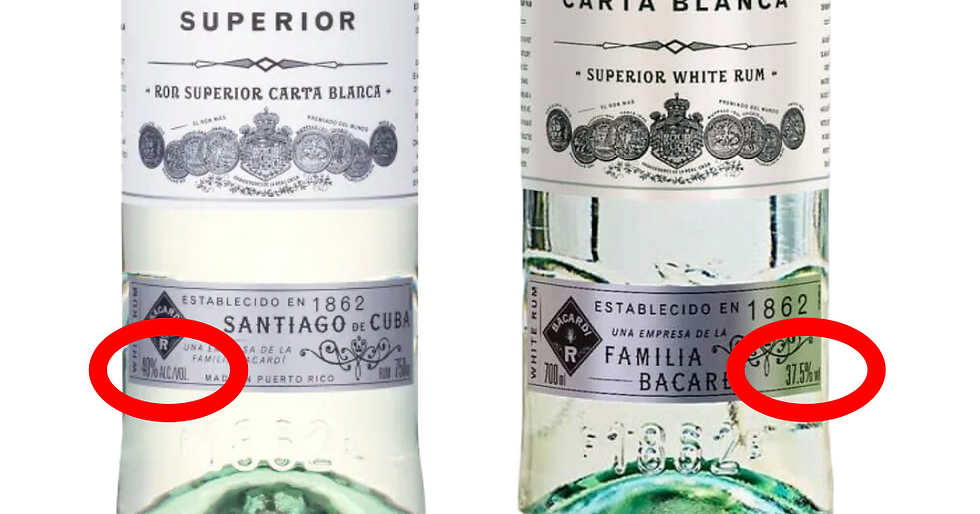What is Rum?
- Idris Van Nuffel

- Oct 9
- 4 min read
Most people know the name 'Rum', but what Rum actually is, remains a mystery to many. Let's solve that right away.
The Technical Part
According to EU regulations, Rum is a spirit that results from the alcoholic fermentation of sugarcane products (molasses, syrups, or juice) and subsequent distillation.
The alcohol percentage during distillation must not exceed 96%.
The minimum alcohol percentage for Rum is 37.5%.
Flavourings are not permitted, with the exception of sugar with a maximum amount of 20 g/liter.
No diluted or undiluted alcohol may be added.
Only added caramel (E150) or molasses may be used to adjust the colour of the Rum.
Every other rule you will find concerns age statements and designations, but in the context of the definition of Rum as a drink, those rules are not relevant.
The Explanation of the Technical Part
Sugarcane
Rum is originally a spirit that originated in the Caribbean through the inventiveness of African slaves who had knowledge of fermentation and distillation and had distilled a strong drink based on molasses, the residual product of sugar production. The perfection of this drink happened in Barbados, where the first real Rum came out of a still. The basis of sugarcane molasses is therefore a historical fact. Later, the French chose to make Rum based on sugarcane juice, and some distillers, for practical reasons, chose to use sugarcane syrup. These two variants are also pure Rums. The basis is therefore always sugarcane. This rule is not plucked from thin air. In addition to the important historical context, the taste of Rum is also 100% determined by the base used. Contrary to what some claim, sugar beet molasses does not taste the same and does not yield the same results.
Rumbelbeet is an example of a drink sold as 'Rum' but does not meet the legal conditions to use this designation.
Alcohol Percentages
Because the taste of Rum is important, the maximum alcohol percentage of 96% during distillation is also not plucked from thin air. Above 96%, the flavour, and thus the essence of Rum, disappears. Most distillers therefore often choose lower percentages, from 70 to 90%, to preserve as much of the flavour as possible.

The minimum alcohol percentage of 37.5% is honestly quite arbitrary, and in practice, it is only very commercial Rums that are given this low alcohol percentage. Some of these you will only find in Belgium due to our very high excise duties. In practice, almost all Rums are 40% or higher. In Latin America, you will also find Rum with 35%. In the EU, this is legally not classified as Rum.

Flavourings
The addition of flavourings, with the exception of 20 g of sugar per litre, is not permitted. In a way, this is quite recent, but it has major consequences, as it immediately eliminates all Spiced Rums. You will now find these under the name 'Spirit Drink'. Rums that were very sweet are now also no longer labelled as Rum and often receive the same labels of 'Spirit Drink' or 'Liquor'.

Other Additions
No diluted or undiluted alcohol may be added either. This is the result of a very dubious practice where only a fraction of the bottle contained Rum to retain the taste of Rum. The rest of the bottle was supplemented with diluted neutral, much cheaper alcohol of poor quality.
Colour
The colour of Rum is sometimes a point of contention, but in essence, the colour plays no role. The only rule is that no colourings other than molasses or caramel (E150) may be added. In practice, molasses is exceptionally used, as it has a huge influence on the taste. Caramel, on the other hand, has little to no influence on the taste when used sparingly. Caramel is mainly used to correct colour. The indication that colourings have been added is not mandatory in the EU, but it is in Germany. That is why you will usually find 'Mit Farbstoff' on the bottle. On the other hand, colour may be filtered out of the Rum, despite the negative consequences for the taste.
The Conclusion
Rum is not very strictly regulated at the base, but applying these rules does ensure a product of good quality, even when the limits are pushed. Even when strictly applying these rules, you obtain beautiful and interesting products, as the rules leave a lot of room for experimentation, which benefits the variation in flavours, colours, and prices. It also ensures that Rum remains an accessible drink for every drinker.
What is striking is that when you apply the above rules to the products you find in supermarkets and large webshops under the name 'Rum', a large part, perhaps even the majority, of the offer does not comply with these rules. In most cases, the alcohol percentage will be lower than the mandatory 37.5% and a range of additives will have been added. Take a closer look at the label and you will notice that it does not say 'Rum', but 'Rum based Spirit drink' or even 'Spirit drink' or 'Rum based liquor'. All wording indicating a deviation from the rules to be a Rum. This does not mean that those products are necessarily of inferior quality, but it is no longer legally a Rum, which unfortunately opens the door for dubious practices. We are always vigilant against misuse and we are careful about stocking these Spirit Drinks. That is why we will also soon optimize our webshop to make a clear distinction between what is real Rum and what is not. This way, you as a consumer are better informed.





Comments